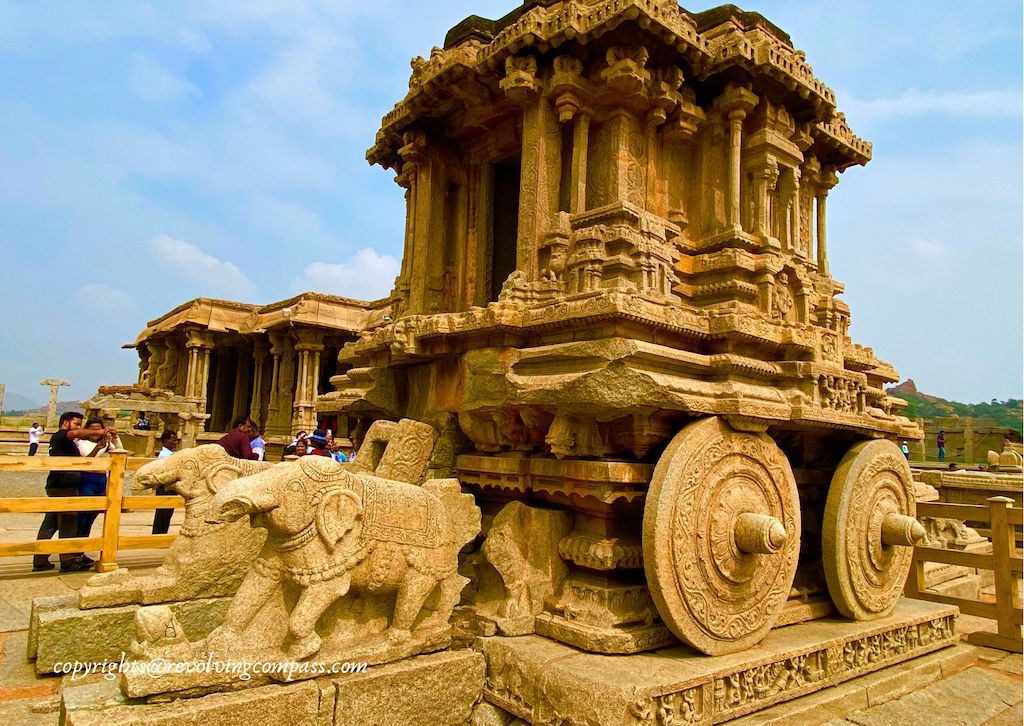Huge Royal Enclosures that speak luxury !
International Trade Markets from before the era of Christ !
Temples with architecture most brilliant and stunning !
Spread over acres and acres of land & spanning thousands of years !
Welcome to Hampi – the largest open air museum of India. If you like visiting historical places you will definitely be in for a treat at Hampi – the UNESCO World Heritage site of Karnataka, India. Which once flourished as one of the richest kingdoms in the world. And was the epitome of cultural and architectural brilliance. In fact, the kingdom of Hampi had markets where international traders came for trade, had cultural events where artists from across the world were invited. The era of the Vijayanagara Empire in Hampi was one of the most glorious for India.
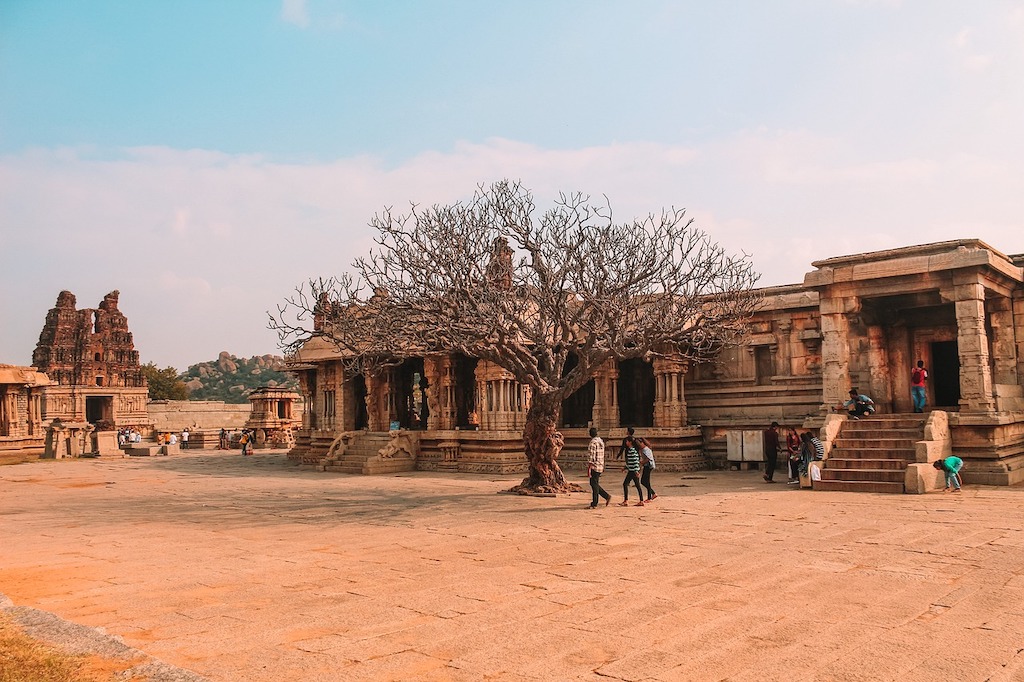
Table of Contents
About Hampi – the largest open air museum of India
History of Hampi – Ramayana Era
Although most of the glorious structures of Hampi are attributed to the Vijayanagara Empire. But actually, it’s past goes back upto the era of Ramayana. And even the Puranas. It was then called “Pampa Devi Tirtha Kshetra” . Because it is believed, Pampa Devi, a form of Goddess Parvati, resided in this region. Goddess Parvati did meditation for years and attended spiritual power while staying in this region. And this is where Shiva and Parvati got married. Also, when they got married, it is believed that showers of gold from heaven blessed the region. Forming the “Hemkuta Hills” which you will see right besides the Virupaksha Temple in Hampi.
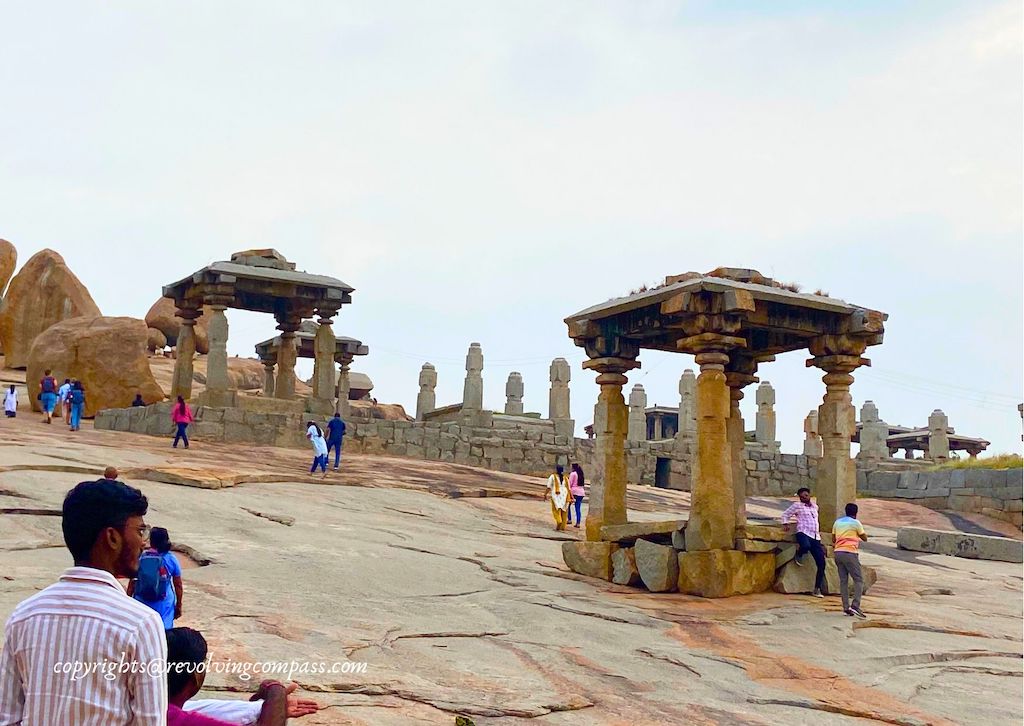
In fact the word “Pampa” is a sanskrit word which over time transformed into “Hampa” – a kannada version. And finally this place came to be known as Hampi. Even the river Tungabhadra on whose bank Hampi is located was called Pampa River for the same reasons.
Another legend from Ramayana states that this is where Vali and Sugriv got into a fight. The two of them threw huge boulders on each other. And that is what explains the huge monolithic granite boulders that you see all around Hampi.
How interesting!!
History of Hampi – The grandeur of Vijayanagara Empire
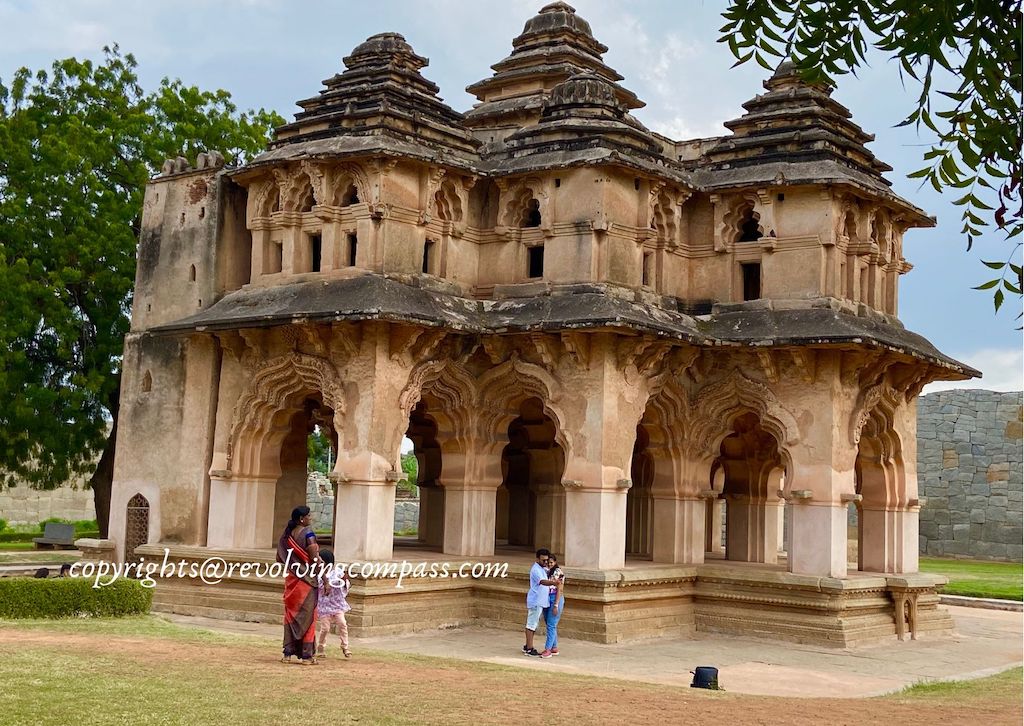
As early as 2nd century BC, Hampi was part of the great Maurya Empire of emperor Ashoka. The evidence of which is found in the form of coins and artefacts excavated in Hampi. Later, it was also ruled by the Chalukyas and Hoysala. In fact, it was the Chalukyas who commissioned land for construction of Virupaksha Temple in Hampi.
During the 13th to 15th Century, Hampi saw a rise in power. As the Vijayanagara Empire flourished in this region. The Vijayanagara Kings were not only progressive. But also great patrons of art. As a result, art, architecture and creativity flourished in their kingdom. The result of which is the numerous ancient temples, large and small with intricately carved pillars and painted ceilings like none other. And enormous royal structures all around Hampi including palaces, markets, stables for horses and elephants, stepped water tanks, water reservoirs and a lot more.
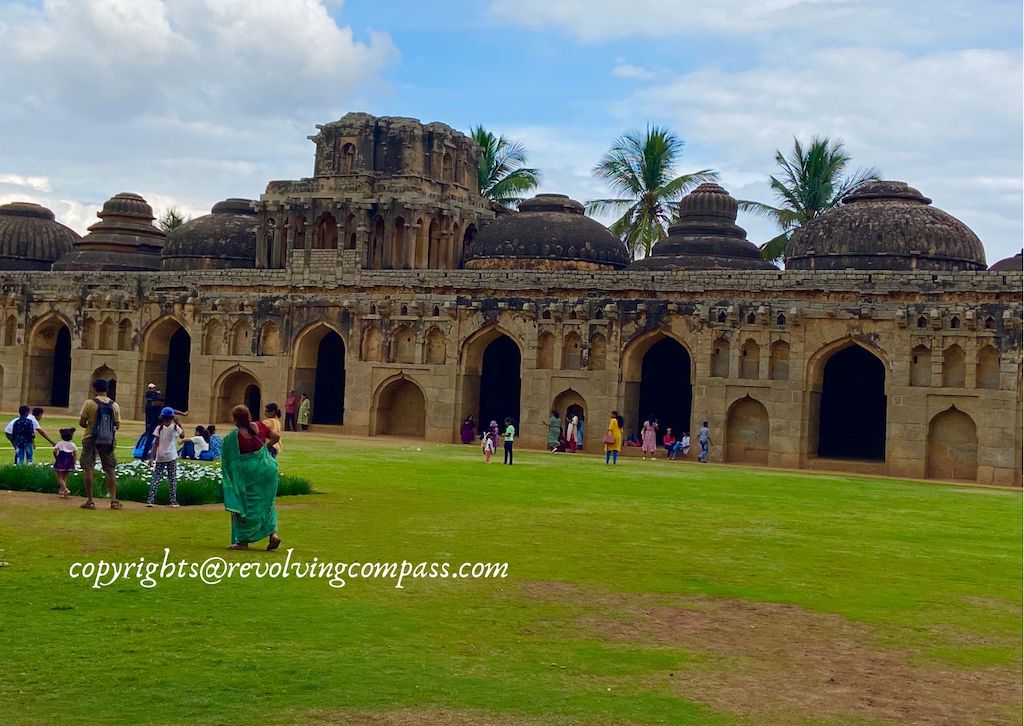
Hampi was so prosperous that traders from as far as Persia (current day Iran) and Portugal traveled here for trade and business deals. There were huge markets setup in this area for encouraging smooth trade. As of today, we can visit seven such huge markets in Hampi. In fact, as per some writings and accounts of travellers, Hampi was the second most prosperous and largest town of this era, after Beijing.
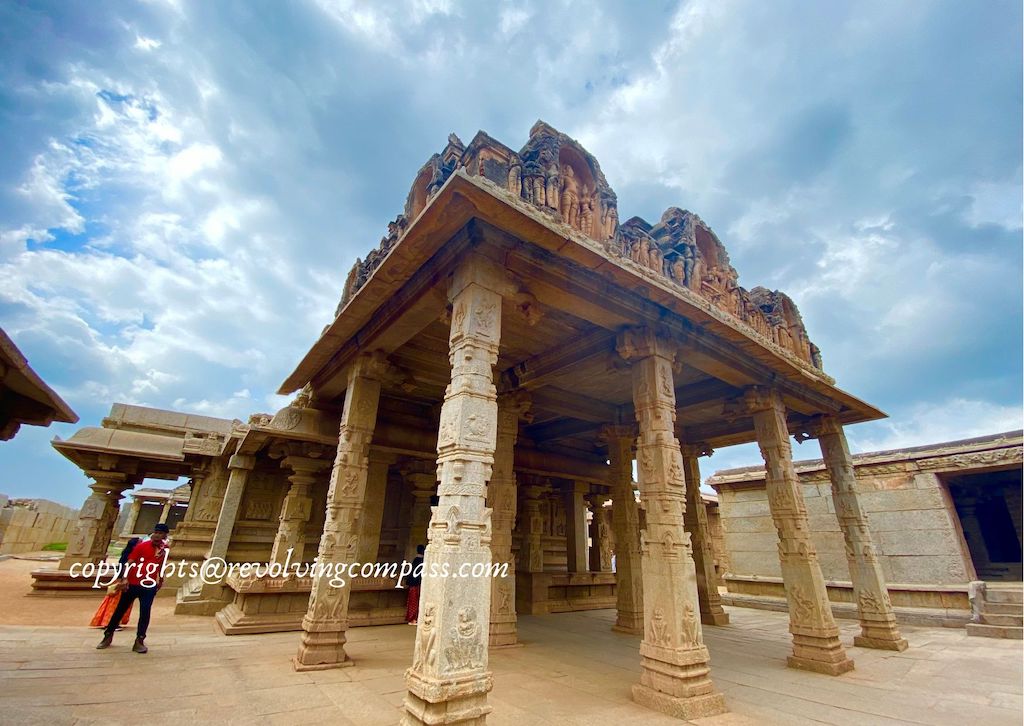
Alas, from around 15th Century, the Muslim Rulers of the North attacked Hampi several times. And finally defeated the then king of Hampi. What followed was reckless plundering and looting of the vast empire of Hampi that continued for over 6 months. At the end of which, the kingdom was completely abandoned. And turned into a ghost town. And became what we today know it as – the monuments of Hampi or the UNESCO World Heritage site in Karnataka.
The cultural heritage tour of Karnataka – Hampi, Badami, Pattadakal & Aihole
Hampi is often visited along with Pattadakal, Aihole and Badami as a cultural circuit of North Karnataka. Aihole is fondly called the “school of temple architecture” in India. As it is a very interesting place where one can see prototypes of several famous temples of India. It is believed that the art of temple architecture started here, and a lot of practice was done on prototypes.
PS: Visiting Aihole – the birthplace of temple architecture in India
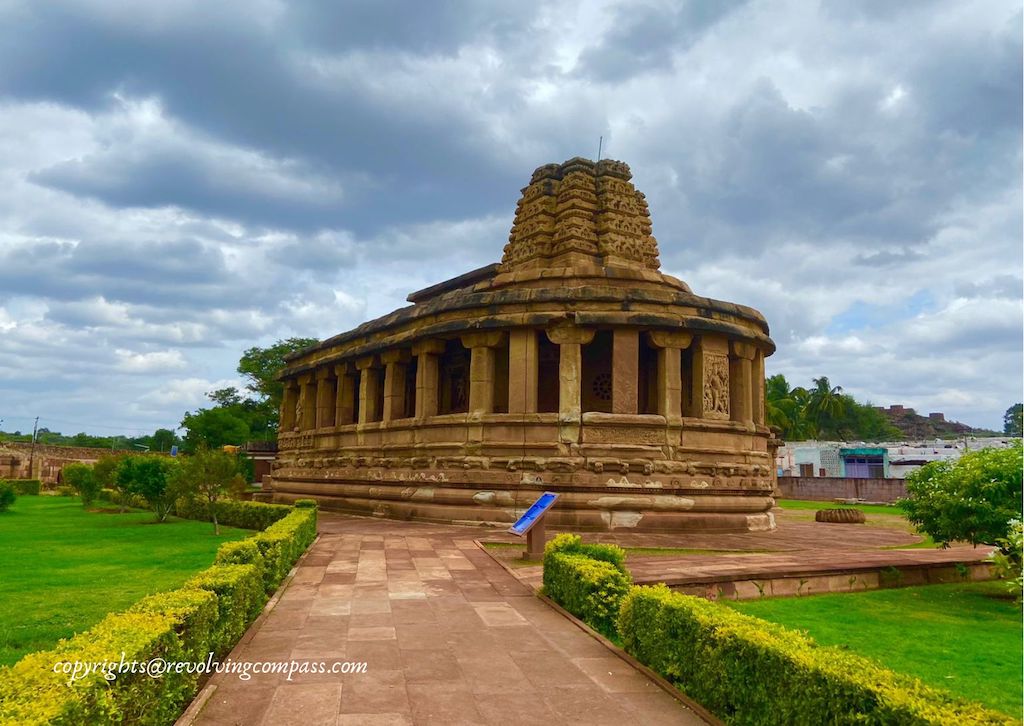
Pattadakal, on the other hand, just 10km from Aihole, is called the “University of Temple Architecture in India”. As the artists gained perfection, they created huge and stunning temples. Which stand today in the Pattadakala Temple Complex. This is another UNESCO World Heritage site in Karnataka.
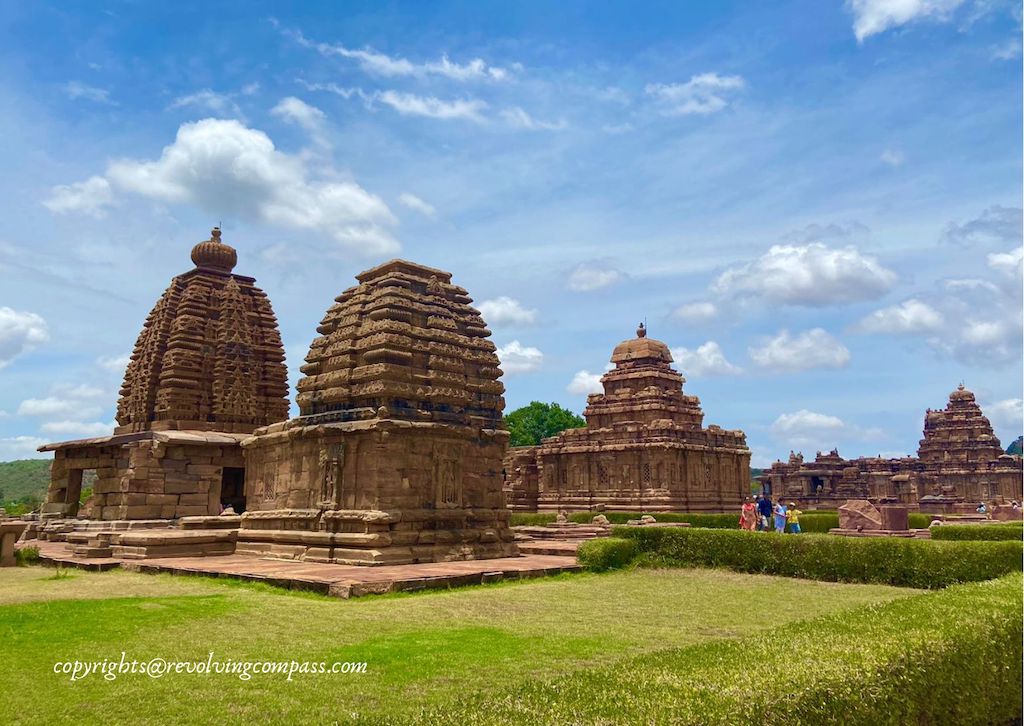
And around 10km to Pattadakal is Badami – the sandstone hill surrounded valley of Malaprabha river where you will see rock cut cave temples of Badami like nowhere else. The beautiful Bhootnath Temple on the banks of Lake Agastya. And several other architectural wonders to discover in Badami will await you.
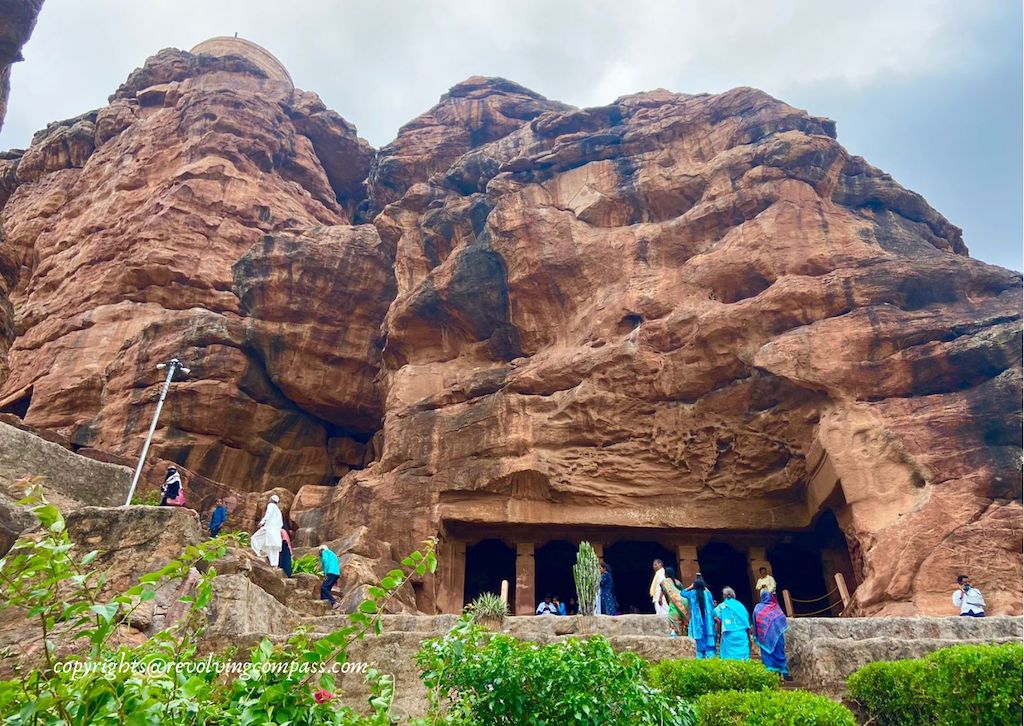
Often one can do a trip to Hampi, Badami, Pattadakal and Aihole together. Wherein one can base themselves in Hampi for 3-4 days. And then shift to Badami for couple of more days. From Badami, one can visit Pattadakal and Aihole on a day trip. And spend the other day exploring Badami. We visited Badami, Pattadakal and Aihole on a separate road trip from Bangalore. Here’s the details of our trip to Badami, Pattadakal and Aihole.
Badami, Pattadakal and Aihole region was like the cultural centre which flourished in parallel to the kingdom of Hampi which in turn was the main business hub.
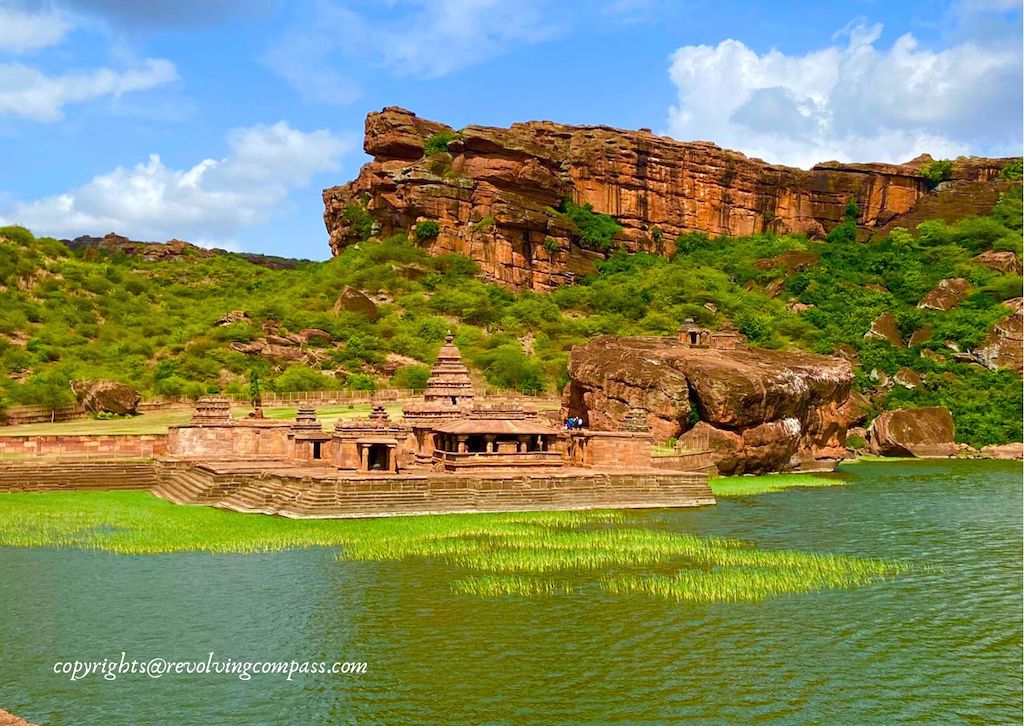
Where to stay in Hampi
Hampi has definitely been gaining a lot of popularity over the last few years. As, when we visited here almost a decade back there was hardly any stay option in Hampi. But, now, it abounds with all kind of accommodation options from humble guesthouses, bed and breakfast, homestays to hotels and luxury resorts. Couple of properties that we have personally stayed in Hampi include –
Our stay experience was good at both of these places. But will definitely prefer Royal Orchid as it was more comfortable and had a lavish breakfast spread.
Some other accommodation recommendations from our guide to visit Hampi, which are worth considering include the following –
Luxury accommodations :
Hotels and homestays with good ratings and proximity to the ruins :
- Clarks Inn Hampi
- Arjun Homestay Hampi
- Gopi Homestay
Here’s a complete list of accommodation in Hampi and the nearby town of Hospet for you to explore.
How to reach Hampi
The ruins of Hampi are located almost 10km from the town of Hospet in Karnataka.
Hospet railway station is located some 15-20km from the ruins of Hampi. There are many hotels in Hospet town as well including some of the above mentioned luxury hotels. In fact, both the times on our trip to Hampi, we stayed in Hospet. You can book an overnight train from Bangalore to Hampi or Hyderabad to Hampi. And from the railway station get an autorickshaw to your accommodation.
Hampi and Hospet are well connected to other towns of Karnataka as well as Andhra via road network. We did a road trip from Bangalore to Hampi. We followed this route on our Bangalore to Hampi road trip :
Bangalore -> Neelamangala -> Tumkuru -> Chitradurga -> Hospete -> Hampi
The highway from Bangalore to Hospet is in excellent condition.
Hospet also has a domestic airport now. So, one can also fly to the town of Hospet and then visit Hampi from there. Although the number of flights are limited. Bangalore and Mysore have more options of flights compared to Hospet.
When is the best time to visit Hampi
Winter months from November to February are considered best to visit Hampi.
However as per my guide to visit Hampi, you will find the pre-monsoon season also an excellent time to explore Hampi. As mostly skies are overcast during this time. And with the pleasant monsoon winds blowing, it really makes for a very nice weather to visit Hampi.
Summer months of March – May are best avoided. As the temperature in this region crosses 40 degrees.
In monsoon season, there is a risk of flooding in Hampi if all of a sudden very heavy rain happens. So, monsoon season should also ve avoided if possible. However, monsoons are often characterised by intermittent dry spells. And you can definitely check the weather forecast and visit Hampi in those dry spells.
How to explore the places to see in Hampi
As per our guide to visit Hampi, you can divide the places to see in Hampi in these major groups.
- Virupaksha Temple and it’s surroundings (Part of the ruins of Hampi Kingdom)
- Vithala Temple and it’s surroundings (Part of the ruins of Hampi Kingdom)
- Royal Enclosure of Hampi (Part of the ruins of Hampi Kingdom)
- Hippie Island Hampi across the Tungabhadra River
- Newly added places to see in and around Hospet Town (Zoo, Park near Tungabhadra Dam etc.)
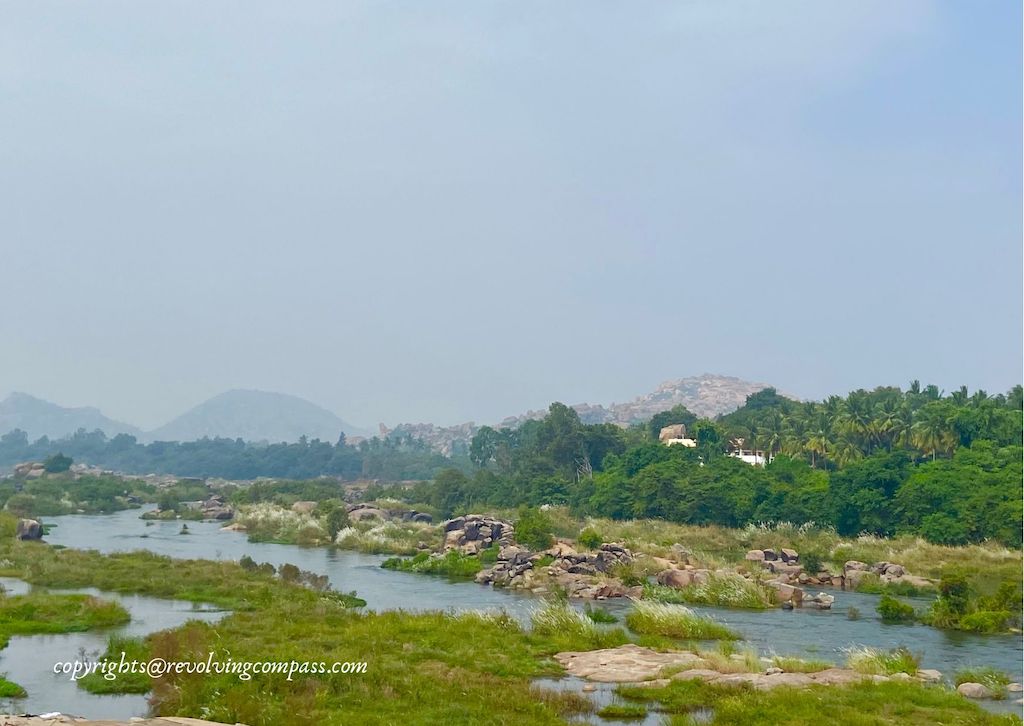
Each one of these is geographically a little distant from the rest. And contains a lot of places to see. So, you can visit each region separately.
You can easily drive to the above three regions in which I have divided the ruins of Hampi. Near each region, you will find a car parking spot where you can park your vehicle and then walk around.
While another good option is to hire a local autorickshaw for a complete day and hop between places using it. Many a times, the autorickshaw drivers are very well informed. Thus, they can act as your guide as well.
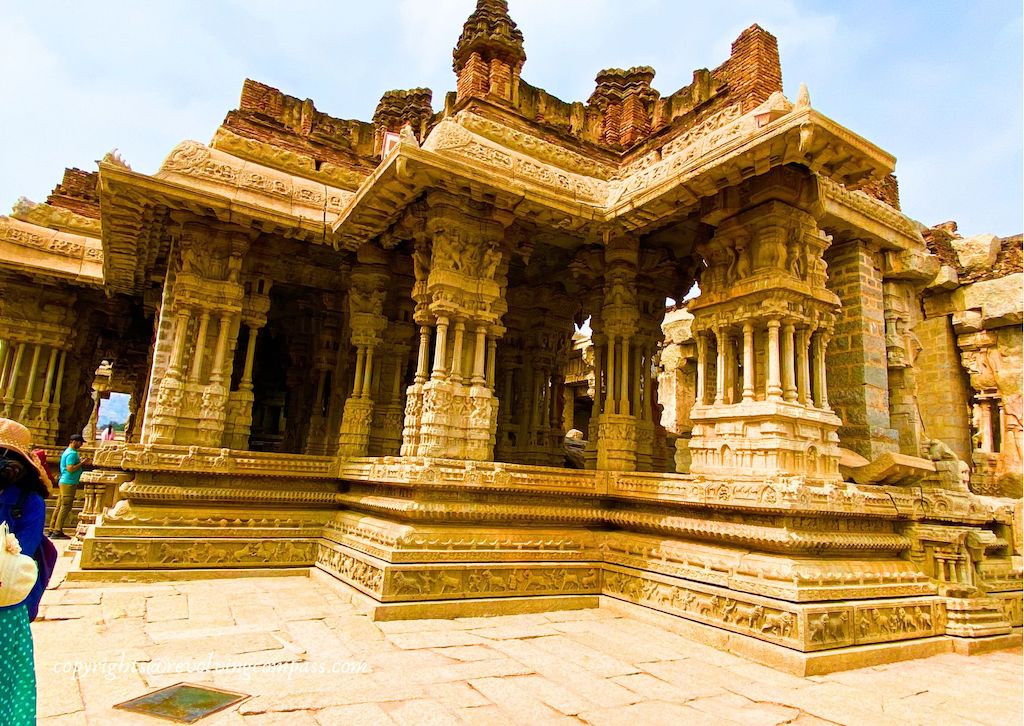
To reach Hippie Island, you can either go via road. Or, take a ferry across the Tungabhadra River on the other side.
As per this guide to visit Hampi, the best is to take breaks between exploring each of the above regions of the ruins of Hampi. As each of these are very extensive. And can be overwhelming with their details.
How many days should I spend in Hampi
This really depends on what all you want to do on your Hampi Trip. If you want to skim through each of the historical ruins then you can visit them all in 2 days. So, you can visit Hampi even over a weekend. Take an overnight train on Friday night. Visit the ruins throughout Saturday from early morning to late evening. Visit the Hippie Islands on Sunday and then take an overnight train back home.
But, if you really want to explore the architectural details of the ruins of Hampi. Then, as per our guide to visit Hampi, you should dedicate a day each to Virupaksha Temple and it’s surroundings, Vittala Temple and it’s surroundings and the Royal Enclosure of Hampi. And then another day to spend some time on the Hippie Island of Hampi.
My first trip to Hampi was very overwhelming. As back then I didn’t have much idea on how to go about exploring the different areas of Hampi. Basically I was unprepared for Hampi. As a result, I mostly explored around Virupaksha Temple and a little bit of the views of Tungabhadra river. But not much beyond that.
Although on my second trip, a 3 days Hampi trip itinerary, I could systematically cover most of the ruins of Hampi across the above 3 trails, I could still not cover Hippie Island. So, I would say, make at least 5 days trip to Hampi to see all the important places to see in Hampi. And experience all that Hampi has to offer.
Guide to visit Hampi – Recommended Hampi Trip Itinerary
As per our guide to Hampi, we recommend two Hampi trip itineraries for you –
Option 1: Take an overnight train from Bangalore to Hampi. Explore the most popular ruins and structures of Hampi. Take an overnight train back to Bangalore on Sunday night.
Option 2: To explore all that Hampi has to offer, follow this itinerary:
Day 1-3 : Explore each of the trails of Hampi each of the days – (1) Virupaksha Temple and around (2) Vithala Temple and around (3) Royal Enclosures of Hampi. Stay in a guesthouse or homestay near the Virupaksha Temple. This way you will get to experience the local life of Hampi more closely. Also, enjoy the hospitality of the locals. And all the ruins are almost walkable from the guest houses.
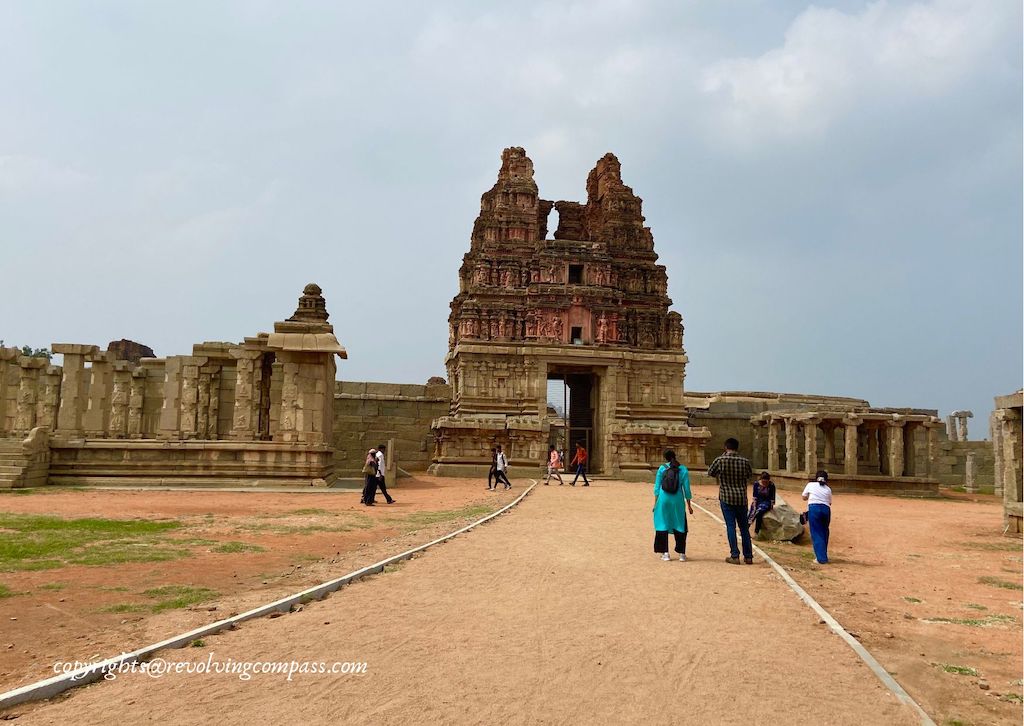
Day 4: Take a coral ride in a traditional round bamboo boat on the river Tungabhadra from the ferry point near Virupaksha Temple. Enjoy the scenery, the islands on river Tungabhadra. And finally go to Hippi Island. Enjoy overnight on this side of Hampi. You can soak in the natural beauty, absorb the vibes of hippie island and enjoy some delicious food in some of the best cafes on this side of Hampi. You can stay overnight on this side of Hampi. At Hampi Boulders Resort or one of the several guest houses on this side of Hampi.
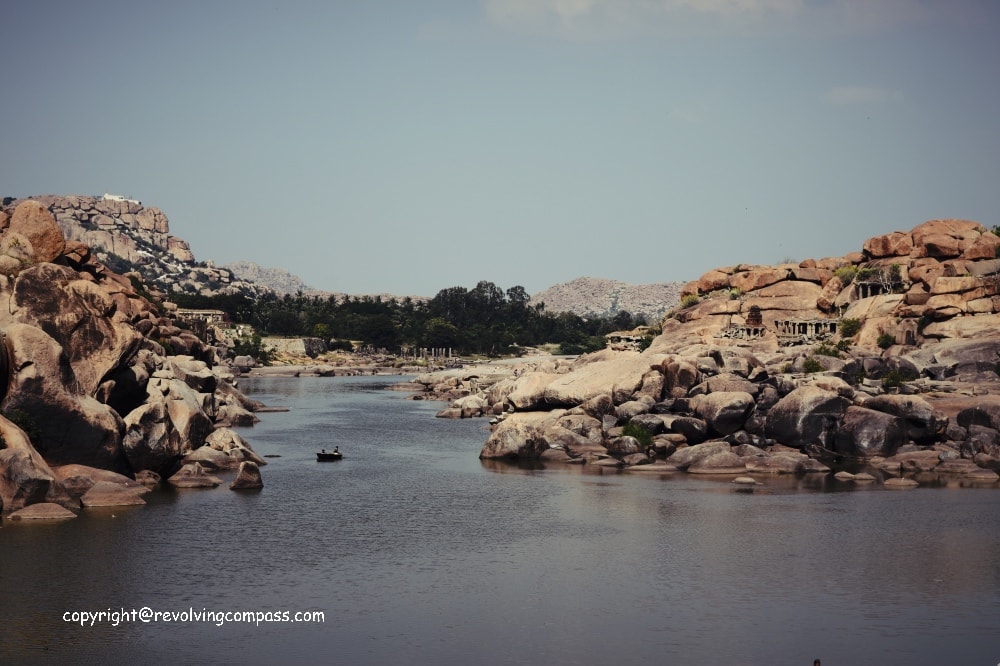
Day 5: Today, move to the town of Hospet. Visit the Tungabhadra Dam, the park near the dam, the zoo etc.
Day 6: This can be the last day of your trip to Hampi. Enjoy a relaxing day in one of the many luxury resorts of Hampi.
Best places to have food in Hampi
Hampi has really evolved over the years as a tourist destination. It has several places to enjoy all kind of cuisines. From humble homemade food that you will get in the lanes behind the Virupaksha Temple. To one of the most luxurious spreads at resorts like Evolve Back and Shivavilas Palace, you will be spoilt by choice.
As per our guide to visit Hampi, you can enjoy north Indian, south Indian, Italian, Continental, Chinese, Tibetian and spanish delicacies in the food outlets of Hampi. Some of the places to eat in Hampi which are highly recommended as per our guide to visit Hampi include –
Happy Buddha Cafe on the other side of the river
Gopi’s Guest House near the Virupaksha Temple
The in-house restaurant at Royal Orchid Hospet where we had enjoyed an enormous spread at very reasonable price.
Naivedyam Restaurant in Hospet Market
PS: Some of our links are affiliated, this means we will earn a commission when you buy a service or product by clicking those links. However, this will have no extra cost for you.
